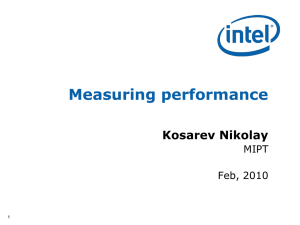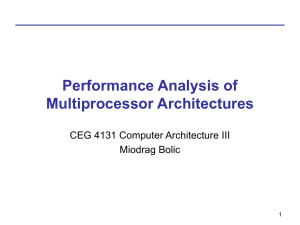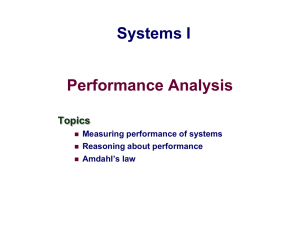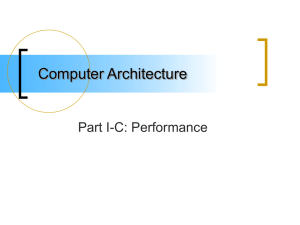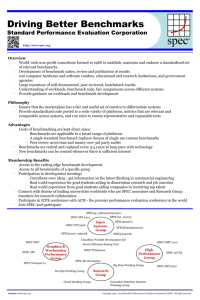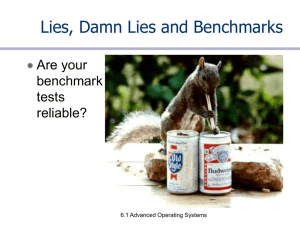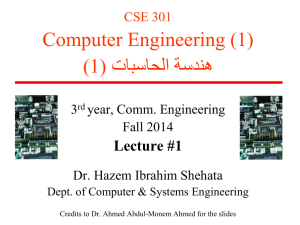Lecture 2: Performance Evaluation
advertisement
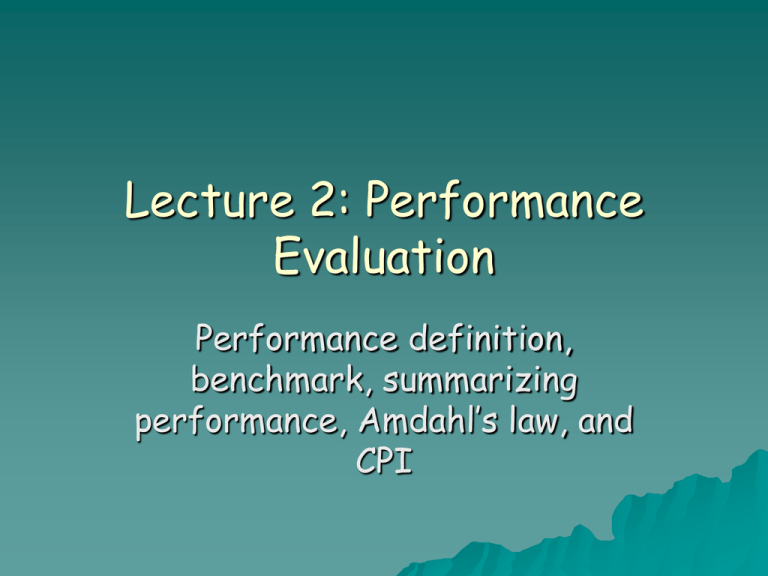
Lecture 2: Performance Evaluation Performance definition, benchmark, summarizing performance, Amdahl’s law, and CPI What Does Performance Mean? Response time – A simulation program finishes in 5 minutes Throughput – A web server serves 5 million request per second Other metrics – MIPS (million instruction per second) – MFLOPS – Clock frequency Execution Time Processor design is concerned with processor consumed by program execution. Shorter execution time=> – Shorter response time – Higher throughput Execution time = #inst×CPI×Cycletime – What affects #inst, CPI, and cycle time? – Almost all designs can be interpreted Any other metrics is meaningful only if consistent with execution time Performance of Computers Performance is defined for a program and a machine. How to compare computers? Need benchmark programs: – Real applications: scientific programs, compilers, text-processing software, image processing – Modified applications: providing portability and focus – Kernels: good to isolate performance of individual features Lmbench: measure latency and bandwidth of memory, file system, networking, etc. – Toy benchmarks – Synthetic benchmarks: matching average execution profile Performance Comparison “X is n times faster than Y”: Performanc e x Executiontimey n Performanc e y Executiontimex n: speedup if we are considering an enhancement, optimization, etc. What does “improving” mean? – Improve performance: decrease execution time, increase throughput – Improve execution time: decrease execution time – Degrade performance: the reverse of the above; brings negative speedup Benchmark Suite Benchmark suite is a collection of benchmarks with a variety of applications – Alleviating weakness of a single benchmark – More representative for computer designers to evaluate their design – Benchmarks test both computer and compilers, and OS in many cases Desktop benchmarks: CPU, memory, and graphics performance Sever benchmarks: throughput-oriented, I/O and OS intensive Embedded benchmarks: measuring the ability to meet deadline and save power Summarizing Performance Given the performance of a set of programs, how to evaluate the performance of machines? A B C P1 (secs) 1 10 20 P2 (secs) 1000 100 20 Total (secs) 1001 110 40 Which computer is the “best” one? Arithmetic Mean Total execution time / (number of programs) 1 n T imei n i 1 – Simple and intuitive – Representative if the user run the programs an equal number of times Weighted Arithmetic Mean Give (different) weights to different programs n Weight T ime , i 1 i i n Weighti 1 i 1 – Considering the frequencies of programs in the workload Geometric Means Based on relative performance to a reference machine n n Execut iont imeratio i i 1 Relative performance is consistent with different reference machines Geometricmean(Xi ) Xi Geometricmean( ) Geometricmean(Yi ) Yi – If C is 2x faster than B (using B as the reference), B is 2x faster than A (A as the reference), then C is 4x faster than A (A as the reference) Harmonic Mean Given speedups s1, s2, …, s_n, the average speedup by harmonic mean is n / (1/s1 + 1/s2 + … + 1/s_n) Why not arithmetic mean? Amdahl’s Law We know about performance: defining, measuring, and summarizing How to maximize performance gains from the beginning in our design? Principle: Make the Common Case Fast! Amdahl’s Law Predict overall speedup from “local speedup” by an enhancement, provided the frequency to use the enhancement is know. – “Local speedup” is related to design and optimization objectives, like to double CPU frequency, to reduce cache latency by half Amdahl’s Law Executiontimenew ExecutionT imeold Fractionenhanced 1 Fractionenhanced Speedup enhance Executiontimeold Speedup overall Executiontimenew 1 Fractionenhanced 1 - Fractionenhanced Speedup enhanced Equation Based on Instruction Types CP U time CP U Clock Cycles Clock cycle time n CP U Clock Cycles IC CP I i i i 1 n CP U time IC CP I Clock cycle time i i i 1 n CP I Instruction frequencyi CP Ii i 1 Make Design Choice Using CPU Time Equation Assume we need to improve the performance of a graphics engine: FP FPSQR Other Frequency 25% 2% 75% CPI 4.0 20 1.33 Alternative 1: CPIFPSQR 20 2 Alternative 2: CPIFP 4 2.5 Which one is better? Calculate speedups. Amdahl’s Law Choice one: Speed up FP Square root by 10x Choice two: Speed up all FP instruction by 1.6x 20% time are used by FP Square root, 50% for all FP inst Which choice is better? Implication: Optimizing for the common case first SPEC CPU Benchmark SPEC: Standard Performance Evaluation Corporation CPU-intensive benchmark for evaluating processor performance of workstation Four generations: SPEC89, SPEC92, SPEC95, and SPEC2000 Two types of programs: INT and FP Emphasizing memory system performance in SPEC2000 SPEC CPU2000 Profiling Dynamic instruction mix Instruction Load int Store int Load fp Store fp Add All fp inst Cond br. All ctrl inst Int avg 26% 10% 19% 12% 16% FP avg 15% 2% 15% 7% 23% 41% 4% 4% Other SPEC Benchmarks SPECviewperf and SPEapc: 3D graphics performance SPEC JVM98: performance of clientside Java virtual machine SPEC JBB2000: Server-cline Java application SPEC WEB99: evaluating WWW servers SPEC HPC96: parallel and distributed computing Server Benchmarks SPEC CPU2000, WBB99, SFS97 TPC Measuring the ability of a system to handle transactions – TPC-C: online transaction processing (OLTP) benchmark (for bank systems) – TPC-H: ad hoc decision make support – TPC-R: decision make support with standard queries – TPC-W: simulating business-oriented transactional web server Embedded Benchmark EEMBC (Embedded Microprocessor Benchmark Consortium) benchmarks – Based on kernel performance – Five classes: automotive/industrial, consumer networking, office automation, and telecommunications Embedded benchmarks are not mature
